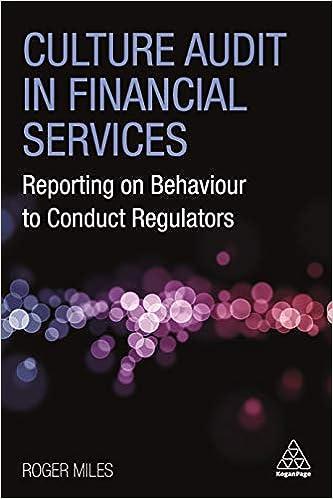Question
Gideon Company uses the allowance method of accounting for uncollectible accounts. On May 3, the Gideon Company wrote off the $4,300 uncollectible account of its
Gideon Company uses the allowance method of accounting for uncollectible accounts. On May 3, the Gideon Company wrote off the $4,300 uncollectible account of its customer, A. Hopkins. The entry or entries Gideon makes to record the write off of the account on May 3 is:
Multiple Choice
-
Accounts ReceivableA. Hopkins 4,300 Bad debts expense 4,300 Cash 4,300 Accounts ReceivableA. Hopkins 4,300 -
Accounts ReceivableA. Hopkins 4,300 Allowance for Doubtful Accounts 4,300 -
Cash 4,300 Accounts ReceivableA. Hopkins 4,300 -
Allowance for Doubtful Accounts 4,300 Accounts ReceivableA. Hopkins 4,300 -
Allowance for Doubtful Accounts 4,300 Bad debts expense 4,300
A company ages its accounts receivables to determine its end of period adjustment for bad debts. At the end of the current year, management estimated that $35,250 of the accounts receivable balance would be uncollectible. Prior to any year-end adjustments, the Allowance for Doubtful Accounts had a debit balance of $1,025. What adjusting entry should the company make at the end of the current year to record its estimated bad debts expense?
Multiple Choice
-
Accounts Receivable 35,250 Bad Debts Expense 1,025 Sales 36,275 -
Bad Debts Expense 36,275 Allowance for Doubtful Accounts 36,275 -
Bad Debts Expense 34,225 Allowance for Doubtful Accounts 34,225 -
Bad Debts Expense 35,250 Allowance for Doubtful Accounts 35,250 -
Accounts Receivable 36,275 Allowance for Doubtful Accounts 36,275
On December 31 of the current year, the unadjusted trial balance of a company using the percent of receivables method to estimate bad debt included the following: Accounts Receivable, debit balance of $98,100; Allowance for Doubtful Accounts, credit balance of $1,051. What amount should be debited to Bad Debts Expense, assuming 4% of outstanding accounts receivable at the end of the current year are estimated to be uncollectible?
Multiple Choice
-
$2,873.
-
$4,975.
-
$1,981.
-
$1,051.
-
$3,924.
The following selected amounts are reported on the year-end unadjusted trial balance report for a company that uses the percent of sales method to determine its bad debts expense.
| Accounts receivable | $ | 440,000 | Debit |
| Allowance for Doubtful Accounts | 1,300 | Debit | |
| Net Sales | 2,150,000 | Credit | |
All sales are made on credit. Based on past experience, the company estimates 3.0% of credit sales to be uncollectible. What adjusting entry should the company make at the end of the current year to record its estimated bad debts expense?
Multiple Choice
-
Debit Bad Debts Expense $13,200; credit Allowance for Doubtful Accounts $13,200.
-
Debit Bad Debts Expense $65,800; credit Allowance for Doubtful Accounts $65,800.
-
Debit Bad Debts Expense $63,200; credit Allowance for Doubtful Accounts $63,200.
-
Debit Bad Debts Expense $14,500; credit Allowance for Doubtful Accounts $14,500.
-
Debit Bad Debts Expense $64,500; credit Allowance for Doubtful Accounts $64,500.
Step by Step Solution
There are 3 Steps involved in it
Step: 1

Get Instant Access to Expert-Tailored Solutions
See step-by-step solutions with expert insights and AI powered tools for academic success
Step: 2

Step: 3

Ace Your Homework with AI
Get the answers you need in no time with our AI-driven, step-by-step assistance
Get Started


